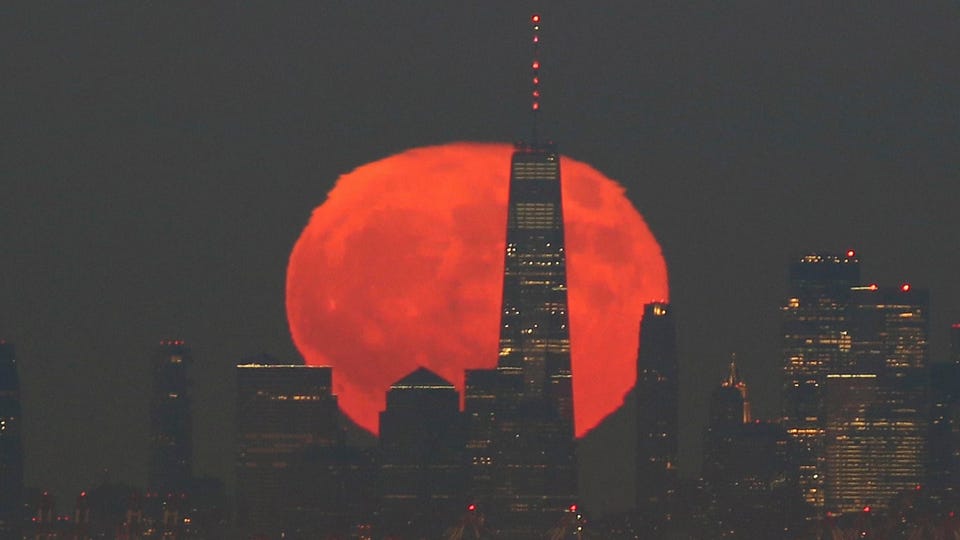Share to Facebook Share to Twitter Share to Linkedin A full Moon rises behind lower Manhattan and One World Trade Center in New York City on Halloween on . . .
[+] October 31, 2020 as seen from Greenbrook Township, New Jersey. (Photo by Gary Hershorn/Getty Images) Corbis via Getty Images Each Monday I pick out the northern hemisphere’s celestial highlights (mid-northern latitudes) for the week ahead, but be sure to check my main feed for more in-depth articles on stargazing, astronomy, eclipses and more. What To See In The Night Sky This Week: July 11-17, 2022 It’s time for a “supermoon”—one of the closest full Moons to our planet this year—though the beautifully big moonrise in clear skies mid-week will be quickly followed by some excellent views of the naked-eye planets.
ADVERTISEMENT Here’s what’s going on in the night sky this week: Wednesday, July 13, 2022: A full ‘Super Buck Moon’ Check the exact times of moonrise and moonset for your location and get somewhere high-up with a good, clear view of the eastern horizon. You reward—just after sunset—will be the rise of one of the biggest-looking full Moons of the year. Known as the “Buck Moon,” “Hay Moon” and “Thunder Moon,” it will hang fairly low all night in the southeast-south-southwest sky before setting close to sunrise.
It’s at moonrise (and moonset) that you want to see it. ADVERTISEMENT Thursday, July 14, 2022: Waning gibbous Moon and Saturn Stellarium Thursday, July 14, 2022: Moon and Saturn Now 96% illuminated, the waning gibbous Moon will shine about 6º from Saturn in the night sky. Look southeast about midnight.
Any small telescope will show you the rings of Saturn. Friday, July 15, 2022: Waning gibbous Moon and Saturn Stellarium ADVERTISEMENT Friday, July 15, 2022: Moon and Saturn Now 91% illuminated, the late-rising waning gibbous Moon will rise just below Saturn in the early hours. Sunday, July 17, 2022: A parade of planets Stellarium Sunday, July 17, 2022: A parade of planets and stars Stay up really late or more likely get up before sunrise and in the southern sky you’ll see the bright planets Venus, Mars, Jupiter and Saturn line-up.
An 82%-lit waning gibbous Moon will be between Saturn and Jupiter. ADVERTISEMENT Crowds look on as the super moon rises behind the Fremantle War Memorial at Monument Hill on . .
. [+] November 14, 2016 in Fremantle, Australia. A super moon occurs when a full moon passes closes to earth than usual, with the November 14th moon expected to be closer than it has been in over 70 years.
(Photo by Paul Kane/Getty Images) Getty Images Object of the week: Moonrise Despite being known for being big and bright, by far the best time to watch the any full Moon—including the “Buck Moon”—is as it appears on the horizon. When observed close to the horizon, not only is the full Moon less bright, but it’s a muted orange that gradually turns to a pale yellow, which slowly brightens as it rises higher in the sky. Why the weird colors? Earth’s oxygen and nitrogen-rich atmosphere absorbs some wavelengths of light more than others.
Light with short wavelengths—such as blue—hit more particles and are more easily absorbed and scattered. That’s why the sky is blue. Colors with longer wavelengths—such as orange—are not absorbed as easily.
So when you look at a sunset, a sunrise, a moonrise or moonset, you’re looking at something close to the horizon, where the atmosphere is thickest. The yellow, orange and red end of the spectrum therefore dominate the light that makes it to your eyes. ADVERTISEMENT Add all that to the “supermoon effect”—a bigger-looking Moon—and you’ve a very special moonrise to go witness this week.
Wishing you clear skies and wide eyes. .
From: forbes
URL: https://www.forbes.com/sites/jamiecartereurope/2022/07/10/a-full-super-buck-moon-and-a-parade-of-planets-what-to-see-in-the-night-sky-this-week/
